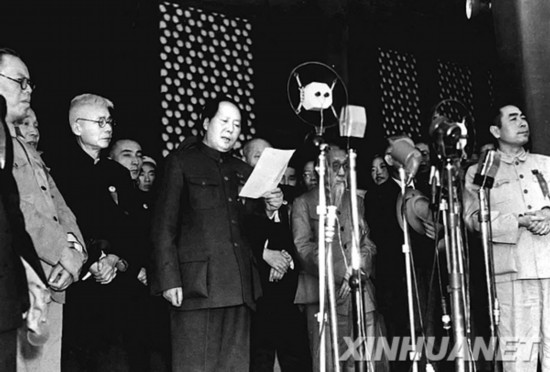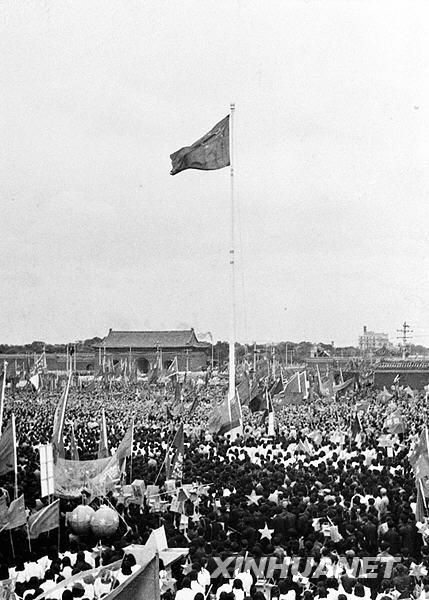
Mao Zedong gives a speech, announcing the founding of the People's Republic of China, at Tian'anmen Rostrum, Beijing, China, October 1, 1949. /Xinhua
Mao Zedong gives a speech, announcing the founding of the People's Republic of China, at Tian'anmen Rostrum, Beijing, China, October 1, 1949. /Xinhua
On October 1, 1949, a grand ceremony announcing the birth of the People's Republic of China was held in Tian'anmen Square. In his heavy Hunan accent, Chairman Mao Zedong gave a speech that set off cheers and jubilation. The pride in hearing these words – "Today, I hereby declare the formal establishment of the People's Republic of China and its Central People's Government" – still reverberate across China today.
But while people are mostly familiar with the dribs and drabs of the ceremony's most precious moments, few know anything about the anecdotes that characterized the event's ethos, and they are quite intriguing.
The hidden explosives
On the eve of the ceremony, security officer An Kewen, along with his squad, was dispatched to check the security situation in Tian'anmen Square. As the Tian'anmen Rostrum was under renovation, An surveyed the mats hanging on the walls designed to shield it from sunlight. And he soon noticed something strange – the smell of flames.
He and other security guards tracked down, finding an explosive package placed between two mats. Worse, connecting the package was a fuse dozens of meters long and stretching down to the bottom of the Rostrum. The other end of the fuse was already ignited, with sparkling moving flames accompanied by steady hissing. The site slated to host the new republic's founding ceremony was in imminent danger.
An and his crew quickly cut off the fuse and disarmed the explosives. Decades later, he recounted the encounter to a reporter with surprising calm. "It wasn't a big deal," he said. "We just resumed our work after defusing the explosive package."
The veteran security guard was proud of assuming the duty of protecting Mao. He once wrote to Mao and received a handwritten reply and a photo of the great man and his family. He kept the letter for the rest of his life.
The American colonel
As the ceremony unfolded before cheering Chinese crowds, a uniformed American serviceman standing near the site caught the security officers' attention. He was photographing the military parade that was part of the ceremony.
Cavalry, chariot, artillery and infantry divisions of the People's Liberation Army had lined up in a tidy formation in the eastern part of Chang'an Avenue, which was not far from the U.S. Consulate General.

A division of the People's Liberation Army parades on Chang'an Avenue, Beijing, China October 1, 1949. /CFP
A division of the People's Liberation Army parades on Chang'an Avenue, Beijing, China October 1, 1949. /CFP
As the American soldier did not enjoy diplomatic privileges, the security team believed he was not authorized to film the ceremony.
They immediately reported to the command center and asked for directives.
The command identified the serviceman as David D. Barrett, a China hand who had been to Yan'an, once a revolutionary base in Shaanxi Province, and met CPC leaders including Mao. The command was uncertain about what to do, and referred the matter to Mao himself.
"Oh. It's Colonel Barrett. I know him," Mao said on the Rostrum as he surveyed the jubilation among the hundreds of thousands of Chinese.
"Should we allow him to keep filming the military parade? Should we confiscate his camera rolls?" Commander Nie Rongzhen asked.
"That may be inappropriate," Mao responded, without shifting his gaze from the crowds. "Let him be. It's an open and public event. Let him disseminate for us."
Barrett was then left alone. One of his photographs, Mao's portrayal on the Rostrum, became an exclusive; he captured it after it was put up there briefly on September 30, before a last-minute change was made in the runup to the ceremony.
Precious film in flames
Meanwhile, on the Rostrum, several blue-eyed, blonde-haired young photographers were scurrying around, having apparently been given a free pass to film. Even more surprising, they were directing CPC leaders to adjust for better pictures.
The young photographers were actually a Soviet crew sent by Joseph Stalin to make a documentary about the ceremony. And the free-wheeling access they had was not the only thing granted by the organizers, who had set up a high tower designed specifically for filming and assigned a jeep to assist.

The national flag of the People's Republic of China is formally raised at Tian'anmen Square for the first time in Beijing, China, October 1, 1949. /Xinhua
The national flag of the People's Republic of China is formally raised at Tian'anmen Square for the first time in Beijing, China, October 1, 1949. /Xinhua
The film the Soviets were making was in color, and barely anyone in the CPC command center had seen a color film before. They were curious.
The photographers were tireless and driven, moving their eye-catching equipment around Tian'anmen Square to capture the all-day ceremony's every scene, from Chairman Mao's speech, the flag-raising ceremony and the military parade to the fireworks that burst into the sky at night.
After finishing their work, they cheerfully brought the fruits of their labor – dozens of heavy boxes with piles of film inside - back to their hotel.
They were very pleased, until disaster struck. Only days after the ceremony, the flammable items caught fire in the hotel room, and almost every piece of the film was reduced to ashes.
The young photographers wailed and stomped their feet in huge disappointment. Zhou Enlai, then Chinese premier, went silent for a couple of minutes after learning the news.
Fortunately, the Chinese photographers were able to produce their own documentary in less glamorous black and white. That is why precious scenes of the ceremony have been preserved for future generations.

